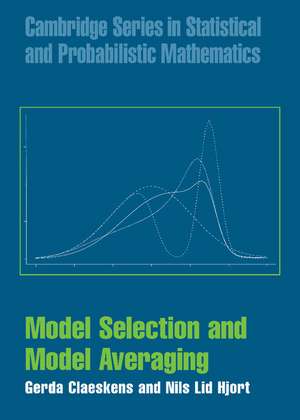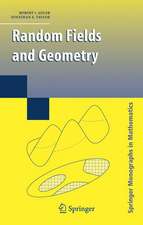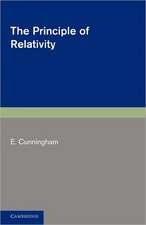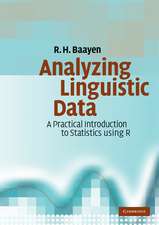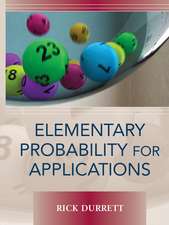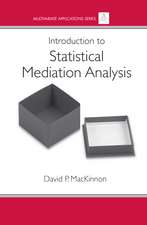Model Selection and Model Averaging: Cambridge Series in Statistical and Probabilistic Mathematics, cartea 27
Autor Gerda Claeskens, Nils Lid Hjorten Limba Engleză Hardback – 27 iul 2008
Din seria Cambridge Series in Statistical and Probabilistic Mathematics
- 20%
 Preț: 282.30 lei
Preț: 282.30 lei - 8%
 Preț: 393.37 lei
Preț: 393.37 lei -
 Preț: 273.60 lei
Preț: 273.60 lei -
 Preț: 310.95 lei
Preț: 310.95 lei - 11%
 Preț: 522.34 lei
Preț: 522.34 lei - 8%
 Preț: 420.35 lei
Preț: 420.35 lei - 11%
 Preț: 669.91 lei
Preț: 669.91 lei - 8%
 Preț: 467.64 lei
Preț: 467.64 lei - 20%
 Preț: 466.18 lei
Preț: 466.18 lei - 11%
 Preț: 710.86 lei
Preț: 710.86 lei -
 Preț: 455.00 lei
Preț: 455.00 lei -
 Preț: 389.13 lei
Preț: 389.13 lei - 8%
 Preț: 500.69 lei
Preț: 500.69 lei -
 Preț: 472.57 lei
Preț: 472.57 lei - 11%
 Preț: 656.39 lei
Preț: 656.39 lei - 20%
 Preț: 688.50 lei
Preț: 688.50 lei - 11%
 Preț: 459.20 lei
Preț: 459.20 lei -
 Preț: 448.80 lei
Preț: 448.80 lei -
 Preț: 411.63 lei
Preț: 411.63 lei -
 Preț: 406.25 lei
Preț: 406.25 lei -
 Preț: 417.11 lei
Preț: 417.11 lei -
 Preț: 412.05 lei
Preț: 412.05 lei - 11%
 Preț: 460.56 lei
Preț: 460.56 lei -
 Preț: 316.34 lei
Preț: 316.34 lei -
 Preț: 463.48 lei
Preț: 463.48 lei - 14%
 Preț: 861.21 lei
Preț: 861.21 lei - 11%
 Preț: 591.23 lei
Preț: 591.23 lei - 11%
 Preț: 594.78 lei
Preț: 594.78 lei -
 Preț: 414.51 lei
Preț: 414.51 lei - 11%
 Preț: 462.29 lei
Preț: 462.29 lei - 11%
 Preț: 584.70 lei
Preț: 584.70 lei - 11%
 Preț: 539.55 lei
Preț: 539.55 lei - 11%
 Preț: 436.85 lei
Preț: 436.85 lei - 11%
 Preț: 567.88 lei
Preț: 567.88 lei - 11%
 Preț: 546.83 lei
Preț: 546.83 lei - 11%
 Preț: 600.93 lei
Preț: 600.93 lei - 8%
 Preț: 384.68 lei
Preț: 384.68 lei - 11%
 Preț: 701.84 lei
Preț: 701.84 lei
Preț: 589.85 lei
Preț vechi: 662.75 lei
-11% Nou
Puncte Express: 885
Preț estimativ în valută:
112.90€ • 122.68$ • 94.90£
112.90€ • 122.68$ • 94.90£
Carte tipărită la comandă
Livrare economică 21 aprilie-05 mai
Preluare comenzi: 021 569.72.76
Specificații
ISBN-13: 9780521852258
ISBN-10: 0521852250
Pagini: 332
Ilustrații: 46 b/w illus. 35 tables 65 exercises
Dimensiuni: 182 x 260 x 26 mm
Greutate: 0.86 kg
Editura: Cambridge University Press
Colecția Cambridge University Press
Seria Cambridge Series in Statistical and Probabilistic Mathematics
Locul publicării:Cambridge, United Kingdom
ISBN-10: 0521852250
Pagini: 332
Ilustrații: 46 b/w illus. 35 tables 65 exercises
Dimensiuni: 182 x 260 x 26 mm
Greutate: 0.86 kg
Editura: Cambridge University Press
Colecția Cambridge University Press
Seria Cambridge Series in Statistical and Probabilistic Mathematics
Locul publicării:Cambridge, United Kingdom
Cuprins
Preface; A guide to notation; 1. Model selection: data examples and introduction; 2. Akaike's information criterion; 3. The Bayesian information criterion; 4. A comparison of some selection methods; 5. Bigger is not always better; 6. The focussed information criterion; 7. Frequentist and Bayesian model averaging; 8. Lack-of-fit and goodness-of-fit tests; 9. Model selection and averaging schemes in action; 10. Further topics; Overview of data examples; Bibliography; Author index; Subject index.
Recenzii
'This is a good textbook for a master-level statistical course about model selection.' Mathematical Reviews
'… given the inviting style of the presentation and the quality of the material, this book could be quite a catch for graduate students as well as for practitioners where models really do make [a] difference.' MAA Reviews
'… the authors have succeeded in bringing together a coherent volume, which gives a state of the art account of the current practice in model selection and comparison, containing a plethora of asymptotic (sometimes new) results, which can be used to compare different model choice criteria. Most importantly, this is the sole volume dedicated to this subject, taking a fully statistical as opposed to an information theoretic approach to the topic of model selection.' Statistics in Society
'… given the inviting style of the presentation and the quality of the material, this book could be quite a catch for graduate students as well as for practitioners where models really do make [a] difference.' MAA Reviews
'… the authors have succeeded in bringing together a coherent volume, which gives a state of the art account of the current practice in model selection and comparison, containing a plethora of asymptotic (sometimes new) results, which can be used to compare different model choice criteria. Most importantly, this is the sole volume dedicated to this subject, taking a fully statistical as opposed to an information theoretic approach to the topic of model selection.' Statistics in Society
Notă biografică
Descriere
First book to synthesize the research and practice from the active field of model selection.
